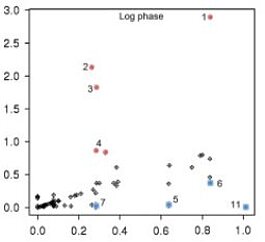YANAvergence
YANAvergence

Reference
https://www.ncbi.nlm.nih.gov/pubmed/21472852)
Latest YANA software version, please cite: Liang C, Liebeke M, Schwarz R, Zühlke D, Fuchs S, Menschner L, Engelmann S, Wolz C, Jaglitz S, Bernhardt J, Hecker M, Lalk M, Dandekar T. Staphylococcus aureus physiological growth limitations: insights from flux calculations built on proteomics and external metabolite data. Proteomics. 2011 May;11(10):1915-35.

Comparing proteomics and metabolomics allows insights into Staphylococcus aureus physiological growth. We update genome and proteome information and deliver strain-specific metabolic models for three S. aureus strains (COL, N315, and Newman). We find a number of differences in metabolism and enzymes. Growth experiments (glucose or combined with oxygen limitation) were conducted to measure external metabolites. Fluxes of the central metabolism were calculated from these data with low error. In exponential phase, glycolysis is active and amino acids are used for growth. In later phases, dehydroquinate synthetase is suppressed and acetate metabolism starts. There are strain-specific differences for these phases. A time series of 2-D gel protein expression data on COL strain delivered a second data set (glucose limitation) on which fluxes were calculated. The comparison with the metabolite-predicted fluxes shows, in general, good correlation. Outliers point to different regulated enzymes for S. aureus COL under these limitations. In exponential growth, there is lower activity for some enzymes in upper glycolysis and pentose phosphate pathway and stronger activity for some in lower glycolysis. In transition phase, aspartate kinase is expressed to meet amino acid requirements and in later phases there is high expression of glyceraldehyde-3-phosphate dehydrogenase and lysine synthetase. Central metabolite fluxes and protein expression of their enzymes correlate in S. aureus.
Download
YANAvergence is an important extension to YANAsquare software, which allows integrating more experimental data to inspect the adaptation of metabolic network under different stresses, conditions.
YANAsquare GUI software package - Download
Requirement: under windows/Linux/Mac system with MASS libraries installed.
Yanavergence R script for fitting experimental data - YANAvergence: yanavergence.rar
YANAvergence (Java 8) is available here - Download
Tutorial
Tutorial and supplementary files for flux computation:
1. List of processes in the strain-specific models and comparison: suppl_1_processes.xls
2. Tutorial on the use of the program YANAvergence: yanavergence_demo.rar
3. Proteome data set: suppl_2_proteins.pdf
4. Condensed Model in SBML format: suppl_0_sac_model.sbml
Former versions
-YANAsquare Software: Download
-YANA Software: Download
-Metatool: Download
BMC Bioinformatics. 2005 Jun 1;6:135. YANA - a software tool for analyzing flux modes, gene-expression and enzyme activities. Schwarz R, Musch P, von Kamp A, Engels B, Schirmer H, Schuster S, Dandekar T. Dept of Bioinformatics, Biocenter, University of Würzburg, Germany.
BACKGROUND: A number of algorithms for steady state analysis of metabolic networks have been developed over the years. Of these, Elementary Mode Analysis (EMA) has proven especially useful. Despite its low user-friendliness, METATOOL as a reliable high-performance implementation of the algorithm has been the instrument of choice up to now. As reported here, the analysis of metabolic networks has been improved by an editor and analyzer of metabolic flux modes. Analysis routines for expression levels and the most central, well connected metabolites and their metabolic connections are of particular interest. RESULTS: YANA features a platform-independent, dedicated toolbox for metabolic networks with a graphical user interface to calculate (integrating METATOOL), edit (including support for the SBML format), visualize, centralize, and compare elementary flux modes. Further, YANA calculates expected flux distributions for a given Elementary Mode (EM) activity pattern and vice versa. Moreover, a dissection algorithm, a centralization algorithm, and an average diameter routine can be used to simplify and analyze complex networks. Proteomics or gene expression data give a rough indication of some individual enzyme activities, whereas the complete flux distribution in the network is often not known. As such data are noisy, YANA features a fast evolutionary algorithm (EA) for the prediction of EM activities with minimum error, including alerts for inconsistent experimental data. We offer the possibility to include further known constraints (e.g. growth constraints) in the EA calculation process. The redox metabolism around glutathione reductase serves as an illustration example. CONCLUSION: A graphical toolbox and an editor for METATOOL as well as a series of additional routines for metabolic network analyses constitute a new user-friendly software for such efforts.








